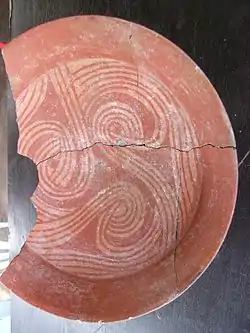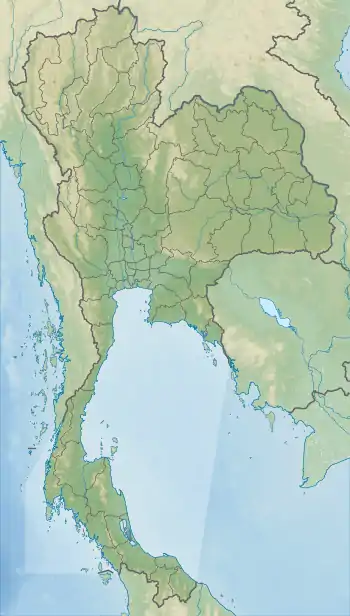Ban Non Wat
Ban Non Wat is a village in central Thailand, in the Non Sung district, Nakhon Ratchasima Province, located near the small city of Phimai. It has been the subject of recent (2002–present) excavation. The cultural sequence encompasses 11 prehistoric phases, which include 640 burials.[1] The earliest is a series of flexed burials thought to represent hunter-gatherers. These were partially contemporary with the initial Neolithic settlement by rice farmers who also raised pigs, hunted a wide range of animals, fished and collected shellfish. There followed a late Neolithic, six Bronze Age and three phases of the Iron Age. This unique sequence has been dated with 76 radiocarbon determinations treated with Bayesian analyses. These reveal that the initial Neolithic settlement took place in the 17th century BC, while the Bronze Age began in the late 11th century BC. The transition into the Iron Age took place in about 420 BC.
 Pottery from the site | |
 Location in Thailand | |
| Site notes | |
|---|---|
| Archaeologists | Charles Higham |
The excavations have been run by Charles Higham, and now by Dr. Nigel Chang and are partially funded by the Earthwatch institute. They are considered by some to be amongst the richest archaeological digs under current excavation. The discovery of remarkably wealthy early Bronze Age burials illustrates profound cultural changes with the advent of copper base metallurgy. WIth the Iron Age, a new range of exotic ornaments accompanied the dead, including carnelian, agate and glass. Later in the Iron Age, the site was surrounded by banks and two moats, which involved the reticulation of water from the adjacent river round the site. The rice fields surrounding the village, although yet to be exhaustively studied, are thought to have been irrigated thousands of years ago, and preliminary dating has supported this theory.
Many of the artifacts recovered have suggested an ongoing link with the Khmer culture, unsurprising given the site's proximity to one end of the Ancient Khmer Highway, at the Phimai Historical Park.
References
- Higham, C. F. W. (2011). The Bronze Age of Southeast Asia: New insight on social change from Ban Non Wat. Cambridge Archaeological Journal, 21(3), 365-389.
Bibliography
- Higham, C.F.W. & Kijngam, A., 2009. The Origins of the Civilization of Angkor. Volume III. The Excavation Ban Non Wat, Introduction. Bangkok, The Fine Arts Department of Thailand.
- Higham, C.F.W. & Kijngam, A., 2011. The Origins of the Civilization of Angkor. Volume IV. The Excavation Ban Non Wat: the Neolithic Occupation. Bangkok, The Fine Arts Department of Thailand.
- Higham, C.F.W. & Kijngam, A., 2012. The Origins of the Civilization of Angkor. Volume V. The Excavation Ban Non Wat: Bronze Age. Bangkok, The Fine Arts Department of Thailand.
- Higham, C.F.W. & Kijngam, A., 2012. The Origins of the Civilization of Angkor. Volume VI. The Excavation Ban Non Wat: Iron Age, Summary and Conclusions. Bangkok, The Fine Arts Department of Thailand.
- Higham C.F.W. and T.F.G. Higham 2009. A new chronological framework for prehistoric Southeast Asia, based on a Bayesian model from Ban Non Wat. Antiquity 82:1-20.